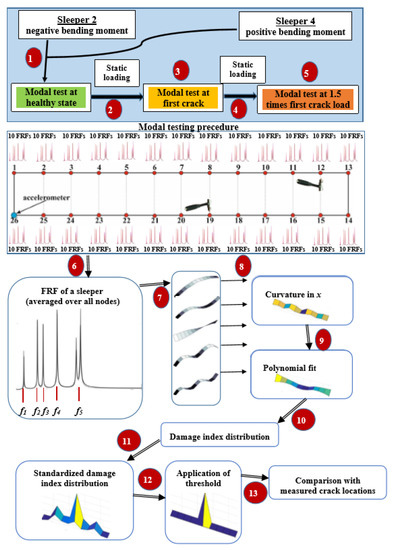Railway prestressed concrete sleepers are a structural and safety-critical component in railway tracks. They are commonly embedded in ballast or gravel to enhance lateral track stability. This practice has prohibited the ability to visually observe or inspect the structural condition of the railway sleepers. It is important to note that damage of a sleeper may not seem to immediately lead to train derailments in a plain ballasted track. However, such the damage can lead to broken switch, bowed crossing, broken welds and wing-rail in switches and crossings or on the transom or railway bridge, potentially resulting in a train derailment from either excessive resultant track geometry defects or progressive component defects. Without proper maintenance or replacement in a timely manner, such the small damage can extend to a larger damage and lead to costly unplanned maintenance costs from aggravated impact loading, unbalanced load transfer, and other consequences caused by broken sleepers [1,2,3,4,5,6,7,8,9,10].
This study is the word first to demonstrate a novel identification technique that is able to locate crack damage in full-scale railway prestressed concrete sleepers. By using dynamic mode shapes of the sleepers, the curvature squares can be used to identify structural cracks in the sleepers. This novel approach adopts structural deflection shapes extracted from experimental modal analysis using an impact excitation [11,12,13,14,15]. In this study, the full-scale railway concrete sleepers are loaded to experience the first crack and exposed to 1.5 times above the first-crack loads using quasi-static loading regimes in accordance with the British Standard as shown in Figure 1.

Figure 1.
Experimental testing and damage localization flowchart.
We are the first to report that the curvature square approach can be used to identify the structural damage in the full-scale railway prestressed concrete sleepers. It is found that accurate locations of structural cracks mostly in the mid span of the sleepers (e.g., centre binding cracks in the field) can be reasonably detected in comparison with the actual crack measurements from the experimental data. Our future work will establish a standardized damage index distributions and subsequent thresholding with different levels of confidence of damage localization to enhance the accuracy of crack localization. The insight into this approach can enhance the development of on-board and on-track technology to identify structural cracks for railway concrete sleepers embedded in ballasted railway tracks using operational modal analysis.
Acknowledgments
The authors are also sincerely grateful to the European Commission for the financial sponsorship of the H2020-RISE Project No. 691135 “RISEN: Rail Infrastructure Systems Engineering Network”, which enables a global research network that tackles the grand challenge of railway infrastructure resilience and advanced sensing in extreme environments (www.risen2rail.eu) [16]. The first author is grateful to Erasmus+ for the financial support for his research internship at the University of Birmingham. The last author wishes to thank the Australian Academy of Science and the Japan Society for the Promotion of Sciences for his Invitation Research Fellowship (Long-term), Grant No. JSPS-L15701 at the Railway Technical Research Institute and The University of Tokyo, Japan.
References
- Kaewunruen, S.; Remennikov, A.M. Experimental simulation of the railway ballast by resilient materials and its verification by modal testing. Exp. Tech. 2008, 32, 29–35. [Google Scholar] [CrossRef]
- Kaewunruen, S. Monitoring in-service performance of fibre-reinforced foamed urethane material as timber-replacement sleepers/bearers in railway urban turnout systems. Struct. Monit. Maint. 2014, 1, 131–157. [Google Scholar]
- Remennikov, A.; Kaewunruen, S. Experimental investigation on dynamic railway sleeper/ballast interaction. Exp. Mech. 2006, 46, 57–66. [Google Scholar] [CrossRef]
- Remennikov, A.M.; Kaewunruen, S. Experimental load rating of aged railway concrete sleepers. Eng. Struct. 2014, 76, 147–162. [Google Scholar] [CrossRef]
- Kaewunruen, S.; Remennikov, A.M. Progressive failure of prestressed concrete sleepers under multiple high-intensity impact loads. Eng. Struct. 2009, 31, 2460–2473. [Google Scholar] [CrossRef]
- Kaewunruen, S.; Remennikov, A.M. Dynamic properties of railway track and its components: Recent findings and future research direction. Insight Non-Destr. Test. Cond. Monit. 2010, 52, 20–22. [Google Scholar] [CrossRef]
- Tuler, M.V.; Kaewunruen, S. Life cycle analysis of mitigation methodologies for railway rolling noise and groundbourne vibration. J. Environ. Manag. 2017, 191, 75–82. [Google Scholar] [CrossRef] [PubMed]
- Rucevskis, S.; Janeliukstis, R.; Akishin, P.; Chate, A. Mode shape based damage detection in plate structure without baseline data. Struct. Control Health Monit. 2016, 23, 1180–1193. [Google Scholar] [CrossRef]
- Kaewunruen, S.; Remennikov, A.M. Sensitivity analysis of free vibration characteristics of an in situ railway concrete sleeper to variations of rail pad parameters. J. Sound Vib. 2006, 298, 453–461. [Google Scholar] [CrossRef]
- Kaewunruen, S.; Sussman, J.M.; Einstein, H.H. Strategic framework to achieve carbon-efficient construction and maintenance of railway infrastructure systems. Front. Environ. Sci. 2015, 3, 6. [Google Scholar] [CrossRef]
- Kaewunruen, S.; Remennikov, A.M. Experiments into impact behaviour of railway prestressed concrete sleepers. Eng. Fail. Anal. 2011, 18, 2305–2315. [Google Scholar] [CrossRef]
- Kaewunruen, S.; Chiengson, C. Railway track inspection and maintenance priorities due to dynamic coupling effects of dipped rails and differential track settlements. Eng. Fail. Anal. 2018, 93, 157–171. [Google Scholar] [CrossRef]
- Kaewunruen, S.; Li, D.; Chen, Y.; Xiang, Z. Enhancement of Dynamic Damping in Eco-Friendly Railway Concrete Sleepers Using Waste-Tyre Crumb Rubber. Materials 2018, 11, 1169. [Google Scholar] [CrossRef] [PubMed]
- Xiang, J.; Matsumoto, T.; Wang, Y.; Jiang, Z. Detect damages in conical shells using curvature mode shape and wavelet finite element method. Int. J. Mech. Sci. 2013, 66, 83–93. [Google Scholar] [CrossRef]
- Wang, Y.; Liang, M.; Xiang, J. Damage detection method for wind turbine blades based on dynamics analysis and mode shape difference curvature information. Mech. Syst. Signal Process. 2014, 48, 351–367. [Google Scholar] [CrossRef]
- Kaewunruen, S.; Sussman, J.M.; Matsumoto, A. Grand challenges in transportation and transit systems. Front. Built Environ. 2016, 2, 4. [Google Scholar] [CrossRef]
Publisher’s Note: MDPI stays neutral with regard to jurisdictional claims in published maps and institutional affiliations. |
© 2018 by the authors. Licensee MDPI, Basel, Switzerland. This article is an open access article distributed under the terms and conditions of the Creative Commons Attribution (CC BY) license (https://creativecommons.org/licenses/by/4.0/).